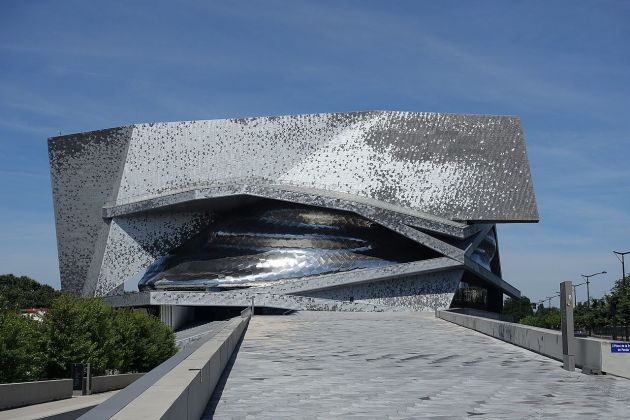 Philharmonie de Paris. Photo by Guilhem Vellut
Philharmonie de Paris. Photo by Guilhem Vellut
From the inside-out Pompidou Centre to a dazzling facades of the Philarmonie de Paris, we look at the most iconic modern architecture in Paris
Paris is known for its elegant nineteenth-century architecture and monumental boulevards. But in amongst these consistently attractive buildings are many examples of strikingly unusual and contemporary architecture. Though this list is by no means comprehensive, these are just 10 of the most of the most captivating modern architectural creations in the city, from the inside-out Pompidou Centre, to a dazzling dome-shaped cinema and the living wall of the Musee du Quai Branly.
 Pompidou Centre. Photo by Stephen Carlile via Flickr
Pompidou Centre. Photo by Stephen Carlile via Flickr
Pompidou Centre
Built by Italian architect Renzo Piano and British architect Richard Rogers and completed in 1977, the two architects won the commission for the Pompidou Centre through a design competition. They famously moved the functional elements of the structure to the outside of the building, allowing the interior gallery spaces to have maximum flexibility. The six-storey building is one of Paris’s best known landmarks and is a hugely influential high-tech building. It houses the largest collection of modern art in Europe.
Read more: The Pompidou Centre is our Icon of the Month
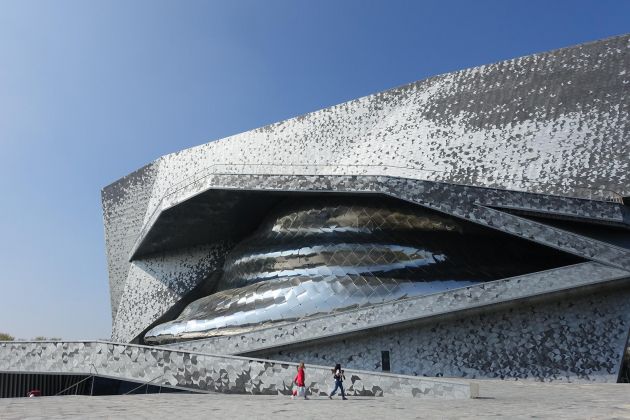 Philarmonie de Paris. Photo by Guilhem Vellut via Flickr
Philarmonie de Paris. Photo by Guilhem Vellut via Flickr
The Philharmonie de Paris
Like the Pompidou Centre, the commission for the Philharmonie de Paris was the result of a design competition, which was won by the architect Jean Nouvel with the assistance of Brigitte Metra. The all-aluminium hill is covered with interlocking, bird-shaped tiles that cover the undulating facades from move across the floors. The effect is almost like metallic snakeskin. The entrance is reached by either a monumental ramp or magnificent stairway, which also both lead up to a rooftop terrace that offers picnic space for up to 700 visitors.
Read more: Jean Nouvel’s Philharmonie de Paris
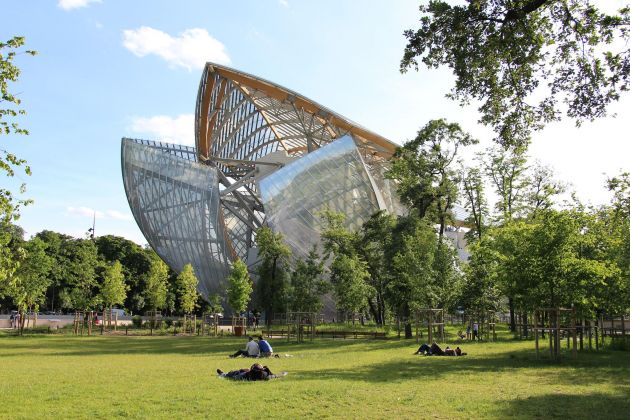 Fondation Louis Vuitton. Photo by Fred Romero
Fondation Louis Vuitton. Photo by Fred Romero
Fondation Louis Vuitton
The Fondation Louis Vuitton was designed by American starchitect Frank Gehry to be an exhibition space for the famous fashion brand. Positioned in the Garden d’Acclimatation, the building is made of sculpted concrete with a curving glass roof that invoke the sails of a ship. The building came in approximately 8 times over its already huge budget
Read more: Frank Gehry’s Fondation Louis Vuitton
Musee du Quai Branly-Jacques Chirac
Like the Philharmonie de Paris, the Musee du Quai Branly was designed by Jean Nouvel. Its recogniseable vertical garden was created by Patrick Blanc. The museum dedicated to indigenous art and non-Western Culture and was designed to house this specific collection. Everything was therefore customised to enhance the experience of those artworks. The architecture itself was intended to challenge Westen creative conventions.
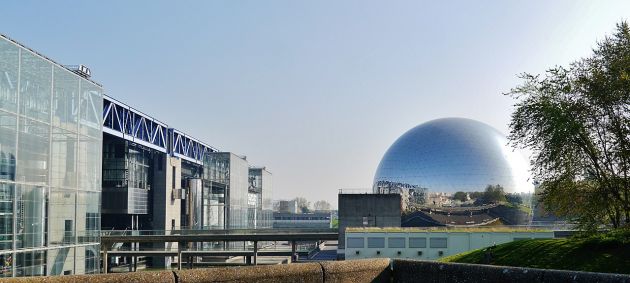 La Geode. Photo by Zairon
La Geode. Photo by Zairon
La Geode
La Geode cinema was designed by architect Adrien Fainsilber and engineer Gerard Chamayou. The mirror-finished geodesic dome is the home of an Omnimax theatre in Paris’s 19th arrondissement.
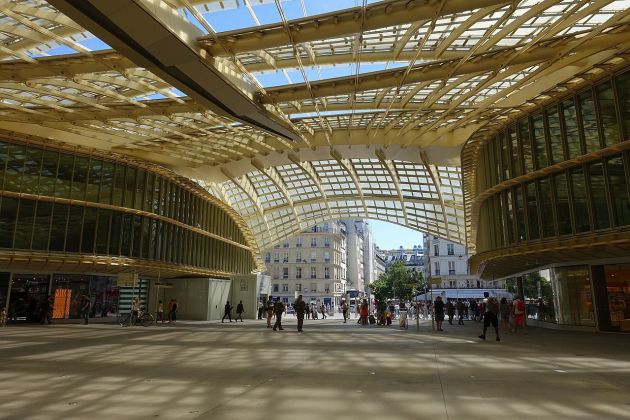 Canopy of Les Halles in Paris. Photo by Guilhem Vellut
Canopy of Les Halles in Paris. Photo by Guilhem Vellut
Les Halles
One of Europe’s largest stations, Chatelet-les-Halles is a cultural centre, cinema, public pool and shopping mall. The complex was renovated by Patrick Berger and Jacques Anziuttu in 2012 to 2016, replacing an infamous 1979 shopping centre that was itself built on the site of a historic marketpiece. The architects added an undulating glass roof canopy structure and moved the entrance to the edge of a large public garden.
French Ministry of Culture and Communication
In 2005 the French Ministry of Culture & Communications headquarters was given a modern twist by architect Francis Soller, who covered the previously austere building with silver steel fishnet.
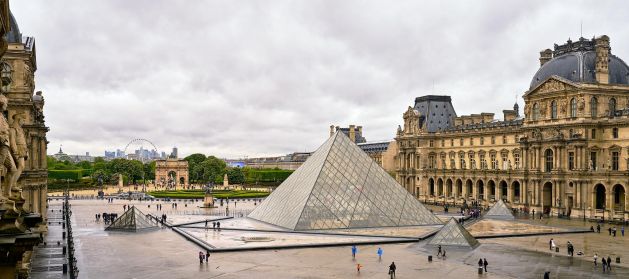 The Louvre. Photo by Pedro Szekely
The Louvre. Photo by Pedro Szekely
Louvre Museum
The Louvre Pyramid was designed by Chinese-American architect I. M. Pei and opened in 1989. The pyramid is made of steel and glass, was commissioned by the French President Francois Mitterand. Though it was controversial when it launched, it has since become one of Paris’s most loved icons.
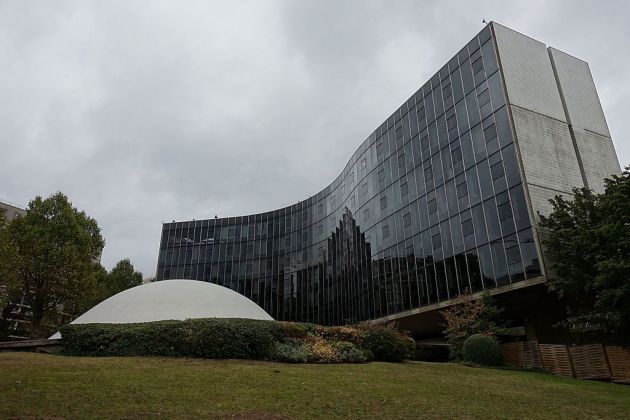 Headquarters of the French Communist Party in Paris. Photo by Guilhem Vellut
Headquarters of the French Communist Party in Paris. Photo by Guilhem Vellut
Headquarters of the French Communist Party
The Headquarters of the French Communist Party was Brazilian architect Oscar Niemeyer‘s first project in Europe. Niemeyer had worked with Le Corbusier in the 1950s on the United Nations Building in New York and had recently finished a couple of other governmental commissions, giving him a good understanding of the relationship between architecture and authority. The building was built between 1967 and 1980. The white dome in the front functions as the ceiling for an underground central debating chamber. Interior walls are curved and light enters the glazed facades.
 Cite de la Mode et du Design. Photo by Lauren Manning via Flickr
Cite de la Mode et du Design. Photo by Lauren Manning via Flickr
Cite de la Mode et du Design
Architecture studio Jakob + Macfarlane built the Cite de la Mode et du Design in 2008 as a venue for fashion and design events. The project started in the hopes of bringing contemporary style to the former industrial site. It has been the home of the Museum of Playful Arts associate since 2013, it also houses restaurants, a nightclub and the IFM school. The Cite is situated on the banks of the Seine River.

















